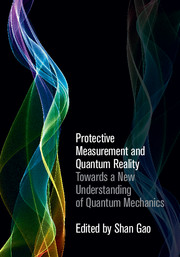Book contents
- Frontmatter
- Dedication
- Contents
- List of Contributors
- Preface
- Acknowledgements
- 1 Protective measurement: an introduction
- Part I Fundamentals and applications
- 2 Protective measurement of the wave function of a single system
- 3 Protective measurement, postselection and the Heisenberg representation
- 4 Protective and state measurement: a review
- 5 Determination of the stationary basis from protective measurement on a single system
- 6 Weak measurement, the energy–momentum tensor and the Bohm approach
- Part II Meanings and implications
- Index
- References
2 - Protective measurement of the wave function of a single system
from Part I - Fundamentals and applications
Published online by Cambridge University Press: 05 January 2015
- Frontmatter
- Dedication
- Contents
- List of Contributors
- Preface
- Acknowledgements
- 1 Protective measurement: an introduction
- Part I Fundamentals and applications
- 2 Protective measurement of the wave function of a single system
- 3 Protective measurement, postselection and the Heisenberg representation
- 4 Protective and state measurement: a review
- 5 Determination of the stationary basis from protective measurement on a single system
- 6 Weak measurement, the energy–momentum tensor and the Bohm approach
- Part II Meanings and implications
- Index
- References
Summary
My view on the meaning of the quantum wave function and its connection to protective measurements is described. The wave function and only the wave function is the ontology of the quantum theory. Protective measurements support this view although they do not provide a decisive proof. A brief review of the discovery and the criticism of protective measurement is presented. Protective measurements with postselection are discussed.
Introduction
In the first graduate course of quantum mechanics I remember asking the question: “Can we consider the wave function as a description of a single quantum system?” I got no answer. Twelve years later, in South Carolina, after I completed my Ph.D. studies at Tel Aviv University under the supervision of Yakir Aharonov in which we developed the theory of weak measurements [1], I asked Aharonov: Can we use weak measurement to observe the wave function of a single particle?
At that time I had already become a strong believer in the many-worlds interpretation (MWI) of quantum mechanics [2] and had no doubt that a single system is described by the wave function. Yakir Aharonov never shared with me the belief in the MWI. When we realized that using what is called now protective measurement, we can, under certain conditions, observe the wave function of a single quantum system, he was really excited by the result. At 1992 I was invited to a conference on the Foundations of Quantum Mechanics in Japan where I presented this result: “The Schrödinger wave is observable after all!”[3]. Then I went home to Tel Aviv where I finished writing a letter which received mixed reviews in Phys. Rev. Lett., while Jeeva Anandan, working on the topic with Aharonov in South Carolina, wrote a paper accepted in Phys. Rev. A [4]. After acceptance of the PRA paper it was hard to fight the referees in PRL, but PLA accepted it immediately [5].
Information
- Type
- Chapter
- Information
- Protective Measurement and Quantum RealityTowards a New Understanding of Quantum Mechanics, pp. 15 - 27Publisher: Cambridge University PressPrint publication year: 2015
References
Accessibility standard: Unknown
Why this information is here
This section outlines the accessibility features of this content - including support for screen readers, full keyboard navigation and high-contrast display options. This may not be relevant for you.Accessibility Information
- 6
- Cited by
